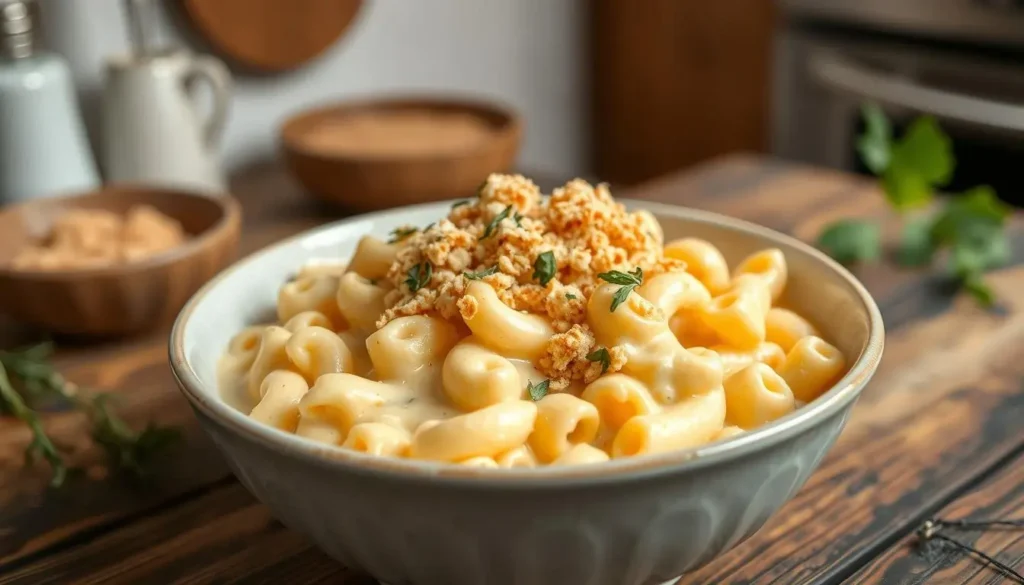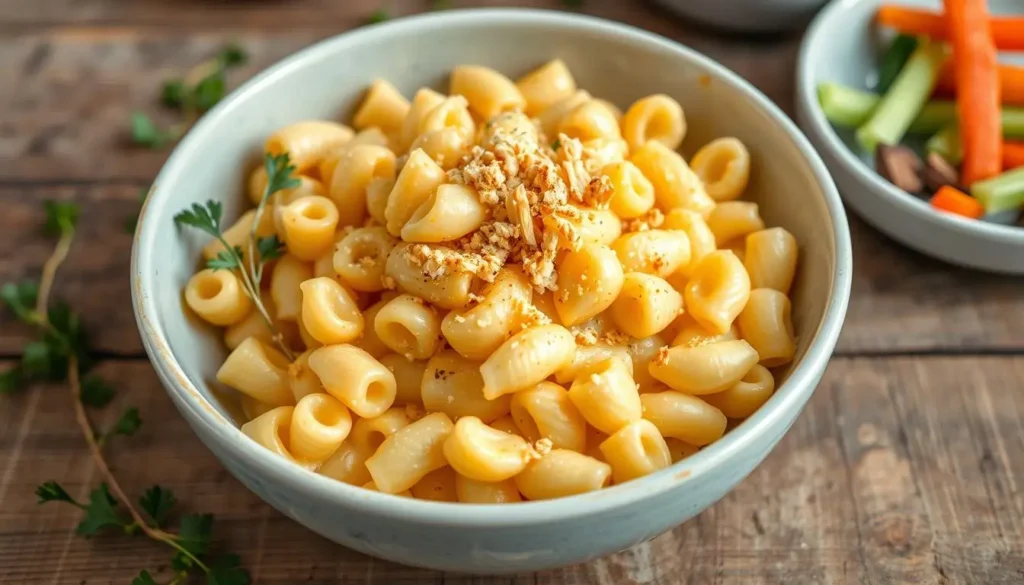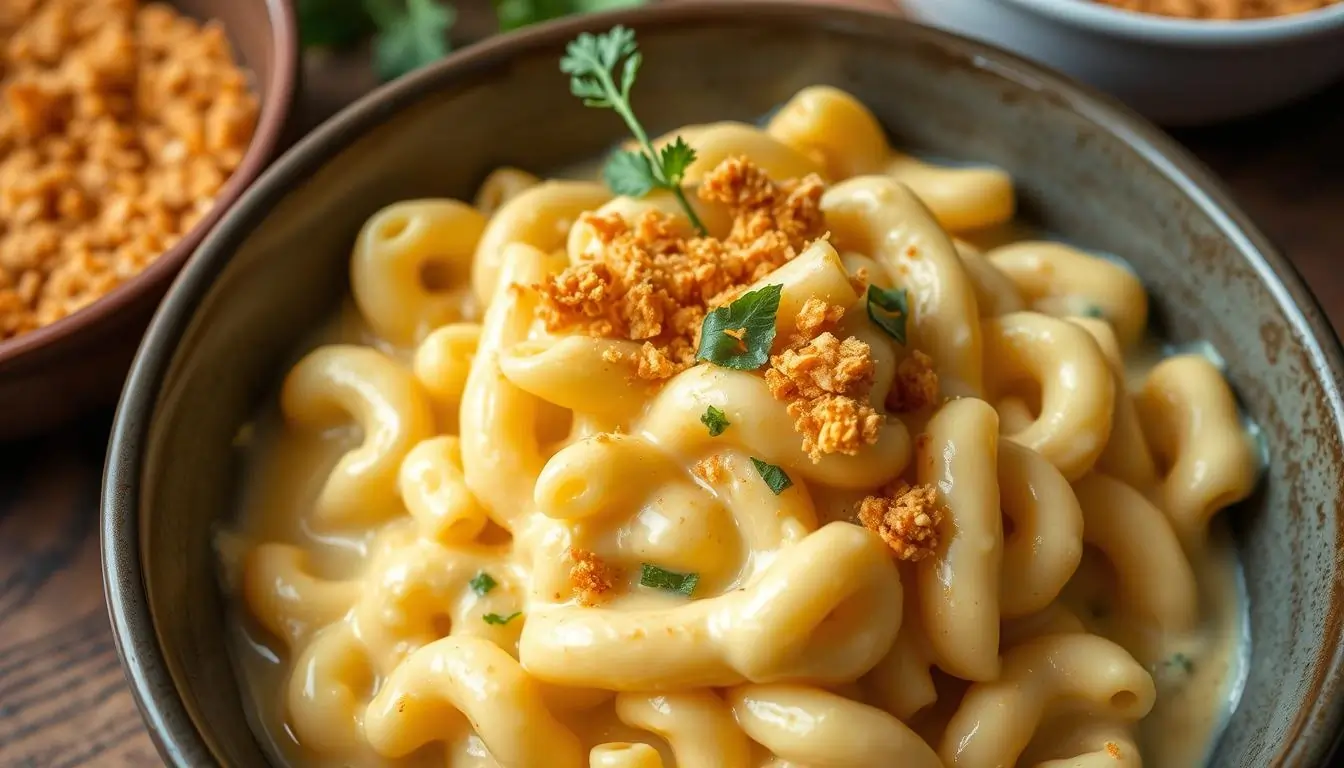As a foodie with gluten sensitivity, finding tasty dishes is tough. But today, I’m excited to share a recipe that’s creamy and cheesy. It’s a gluten-free mac and cheese that will make your taste buds dance.
Mac and cheese have always been comfort food for me. It was like a warm hug in a bowl. But finding a gluten-free version was hard. Now, I have a homemade gluten-free mac and cheese recipe that’s a game-changer. It lets you enjoy all the flavors and textures you love without any gluten.
This submit might also incorporate affiliate hyperlinks. Read my privacy policy. If you
Table of Contents
Why Make Gluten Free Mac and Cheese at Home
Making gluten free mac and cheese at home has many benefits. You get a better taste, save money, and control what goes into it.
Benefits of Homemade vs Store-Bought
Homemade gluten free mac and cheese lets you customize flavors. Store-bought versions often can’t match the creamy texture and rich taste of homemade. You can try different cheeses, spices, and add-ins to make it your own.
Cost-Effectiveness of Making Your Own
Homemade gluten free mac and cheese is cheaper than buying it. The ingredients are affordable, and you can make enough for several meals. It’s a great way to save money, especially for families.
Control Over Ingredients and Flavors
One big plus of homemade gluten free mac and cheese is controlling what goes into it. You can pick high-quality, organic, or specialty items. This way, you avoid additives and preservatives found in store-bought versions.

By making your own gluten free mac and cheese, you get a dish that fits your taste and needs. It’s hard to beat the quality and customization of homemade. This makes it the best choice for a satisfying meal.
| Homemade Gluten Free Mac and Cheese | Store-Bought Gluten Free Mac and Cheese |
|---|---|
| Customizable flavor and ingredient profile Fresher, creamier texture Cost-effective Control over quality and sourcing of ingredients | Limited flavor options Potentially less creamy or flavorful Can be more expensive per serving Ingredients may include additives or preservatives |
Essential Ingredients for Gluten Free Mac and Cheese
If you’re craving a delightful and gluten free mac and cheese dish, you’ll need a few key ingredients. You’ll need gluten-free pasta and a flavorful cheese blend. Each part is crucial for a creamy, satisfying meal that’s safe for those with gluten sensitivities.
First, choose a high-quality gluten free pasta. Look for rice, corn, or quinoa-based options. They offer the same texture as traditional pasta. Always check the packaging for gluten free certifications to ensure it’s safe.
Next, pick a mix of cheeses for the perfect creamy sauce. Use sharp cheddar, gouda, and parmesan for a rich flavor. For creamier sauce, add cream cheese or soft cheeses like fontina or gruyere.
- Gluten-free pasta (rice, corn, or quinoa-based)
- Sharp cheddar cheese
- Gouda cheese
- Parmesan cheese
- Cream cheese (optional)
- Milk or milk alternative (such as almond or oat milk)
- Gluten-free flour or cornstarch for thickening
- Seasonings (such as garlic, onion, salt, and pepper)
To get a smooth sauce, use a milk alternative like almond or oat milk. Also, add a gluten-free thickener like cornstarch or gluten-free flour. Don’t forget your favorite seasonings like garlic, onion, salt, and pepper to boost the flavor of your gluten free mac and cheese.

With these essential ingredients, you’re ready to make a gluten free mac and cheese dish. It will be delicious and safe for those with dietary restrictions.
Choosing the Right Gluten Free Pasta
When making gluten free mac and cheese, picking the right pasta is key. The wide range of gluten free pasta can be overwhelming. But, with some tips, you can find the perfect pasta for your dish.
Best Pasta Types and Brands
Here are some top gluten free pasta types for mac and cheese:
- Quinoa pasta: It has a nutty taste and a firm texture, making it a favorite for gluten free mac and cheese.
- Brown rice pasta: It’s light and chewy, mixing well with creamy cheese sauces.
- Corn pasta: It has a mild taste and a firm bite, making it a great choice for gluten free mac and cheese.
- Chickpea pasta: It’s packed with protein and fiber, adding a nutritious twist to the classic dish.
When picking a brand, choose ones that are certified gluten free. Look for brands like Banza, Barilla, and Jovial Foods.
How to Check for Certification
It’s important to make sure your pasta is gluten free. Look for the “gluten free” label or certifications from groups like the Gluten-Free Certification Organization (GFCO) or the National Foundation for Celiac Awareness (NFCA).
Cooking Time Differences
Gluten free pasta cooks differently than regular pasta. Always follow the package instructions and check the texture often. This will help you get the perfect al dente bite for your gluten free mac and cheese.

By choosing the right gluten free pasta and knowing how to cook it, you can make a delicious and safe mac and cheese dish.
The Perfect Cheese Blend for Maximum Flavor
Creating the ultimate gluten free mac and cheese starts with the cheese blend. The right mix of cheeses turns a simple dish into a masterpiece. They melt together to create a rich, creamy sauce.
To get the perfect gluten free mac and cheese cheese blend, follow these tips:
- Sharp Cheddar – The base of any great gluten free mac and cheese, sharp cheddar adds a bold, tangy flavor.
- Gruyère or Emmental – These Swiss cheeses melt well, adding a nutty, sweet taste that goes well with cheddar.
- Parmesan – A sprinkle of Parmesan adds a savory, umami-rich flavor that brings the cheese blend together.
- Cream Cheese – A bit of cream cheese makes the sauce silky and velvety.
Finding the right mix of bold, melty, and creamy cheeses is key. Try different ratios to find your perfect gluten free mac and cheese blend.
“The quality of the cheese is crucial in gluten free mac and cheese – it’s the star of the show!”
Making the Ultimate Gluten Free Roux
Making a perfect gluten-free roux is key for creamy mac and cheese. Unlike regular roux, gluten-free needs a special approach. This ensures it’s smooth and lump-free. Let’s dive into the steps to master this crucial part of your gluten-free mac and cheese.
Gluten Free Flour Options
There are many gluten-free flours to choose from for your roux. Each has its own benefits and taste. Here are some popular ones:
- Rice Flour: It’s versatile and mild, making a silky roux.
- Tapioca Flour: It adds a chewy texture and thickens the sauce.
- Almond Flour: It gives a nutty flavor and a rich texture.
- Cassava Flour: It’s grain-free and makes a light, airy roux.
Try different flour mixes to find the one you like best for your mac and cheese.
Proper Roux Techniques
Making a great gluten-free roux takes some skill and patience. Here’s how to do it right:
- Melt butter in a pan over medium heat, avoiding browning.
- Whisk in gluten-free flour, stirring constantly to avoid lumps.
- Cook for 2-3 minutes to get rid of the raw flour taste.
- Slowly add milk or dairy-free milk, stirring until smooth.
- Simmer and stir often until it’s the right thickness.
With practice, you’ll make a gluten-free roux that’s perfect for your gluten free mac and cheese.
Step-by-Step Preparation Instructions
Making a tasty gluten-free mac and cheese is simple. Just follow these easy steps to enjoy a creamy, indulgent meal. It’s perfect for satisfying your cravings without gluten.
- Start by cooking the gluten-free pasta as the package says. Make sure to cook it for the right time to get the best texture.
- While the pasta cooks, make the roux. Melt butter in a saucepan over medium heat. Then, whisk in gluten-free flour, stirring constantly to avoid lumps.
- Slowly add the milk or dairy-free milk, whisking until it thickens into a creamy sauce.
- Now, add the shredded cheese, a bit of salt, and pepper. Stir until the cheese melts and the sauce is smooth.
- Drain the pasta and put it in the saucepan with the cheese sauce. Fold the pasta into the sauce until it’s well coated.
- If you want, put the mac and cheese in a baking dish. Sprinkle more cheese or breadcrumbs on top for a crispy layer.
- Then, bake the mac and cheese at 375°F (190°C) for 15-20 minutes. It should be golden brown and bubbly on top.
By following these simple steps, you’ll have a delicious, gluten-free mac and cheese recipe. You can enjoy it anytime, without losing flavor or texture.
Creating a Creamy Sauce Without Gluten
Making a tasty gluten free mac and cheese is all about the sauce. Since gluten helps bind, we need new ways to get a smooth texture. Learning about gluten-free roux and choosing the right dairy can make your mac and cheese amazing.
Achieving the Right Consistency
The secret to a great gluten free mac and cheese sauce is balance. Start with a roux made from gluten-free flour and butter or oil. Cook it until it smells nutty, then add milk or cream slowly. The flour thickens the sauce, and the fats make it creamy.
Troubleshooting Common Issues
- If the sauce feels grainy, cook the roux longer to gelatinize the starches.
- To avoid separation, add dairy slowly while whisking constantly.
- For a silkier sauce, blend in a bit of nut butter or pureed veggies.
With practice, you’ll get a gluten free mac and cheese sauce that’s just as creamy as the original.
| Technique | Benefits |
|---|---|
| Roux-based Sauce | Provides a rich, velvety texture |
| Emulsified Dairy | Prevents separation for a smooth, creamy consistency |
| Blended Nut Butters or Veggies | Adds body and creaminess without gluten |
Baked vs Stovetop Versions
Choosing between a baked or stovetop mac n cheese bake is a common dilemma. Each method has its own benefits, depending on what you like and what you’re aiming for.
The baked gluten-free mac n cheese bake is a timeless choice. It gives a golden, crispy top. This method blends flavors well and makes the cheese sauce creamier, creating a rich dish.
The stovetop gluten-free mac n cheese bake is quicker and more flexible. It’s perfect for fast weeknight meals. You can control the cheese sauce’s creaminess to your liking.
| Baked Gluten-Free Mac n Cheese Bake | Stovetop Gluten-Free Mac n Cheese Bake |
|---|---|
| Yields a crisp, golden top layer | Quicker and more versatile |
| Enhances the creaminess of the cheese sauce | Provides more control over the consistency of the cheese sauce |
| Offers a heartier, more casserole-like texture | Ideal for busy weeknights |
Choosing between baked and stovetop gluten free mac n cheese bake depends on your taste. Whether you like the comforting baked version or the quick stovetop option, both are delicious and satisfying.
Adding Extra Flavors and Mix-ins
Make your gluten free mac and cheese even better with a few simple steps. Add aromatic herbs, spices, protein, and veggies to make it a flavor-packed dish. You can customize your gluten free mac and cheese in countless ways.
Herbs and Seasonings
Start by adding fragrant herbs and bold seasonings to your gluten free mac and cheese. Here are some great combinations:
- Fresh thyme, rosemary, and garlic for an earthy, savory taste
- Smoked paprika, cumin, and chili powder for a smoky, Southwestern flavor
- Dried oregano, basil, and crushed red pepper flakes for an Italian twist
Protein Options
Adding protein makes your gluten free mac and cheese more filling. Try these options:
- Grilled or baked chicken, diced into small pieces
- Crispy bacon crumbles or sautéed pancetta
- Sautéed shrimp or chunks of lobster for a seafood twist
- Crumbled plant-based meat alternatives for a vegetarian choice
Vegetable Additions
Adding fresh or roasted veggies boosts your gluten free mac and cheese. Here are some great options:
- Sautéed spinach, kale, or broccoli florets
- Roasted Brussels sprouts, cauliflower, or diced sweet potatoes
- Sautéed mushrooms, onions, and bell peppers for a veggie-packed mix
Try different flavor combinations to find your favorite gluten free mac and cheese mix-ins.
Tips for Reheating and Storage
Homemade gluten free mac and cheese can be enjoyed for days. The right storage and reheating methods keep it delicious. Here are some tips to keep your gluten-free mac and cheese fresh and creamy.
Storing Leftovers
Store your gluten free mac and cheese in an airtight container in the fridge. It stays good for 3-4 days. When reheating, do it carefully to avoid drying out or becoming gummy.
Freezing for Later
You can freeze gluten free mac and cheese for longer storage. Cool it down, then portion it into servings or containers. Seal them tightly and freeze for up to 3 months. Thaw it in the fridge before reheating.
Reheating Methods
- Stovetop: Put the gluten free mac and cheese in a saucepan. Heat it over medium-low, stirring often, until warm.
- Oven: Preheat to 350°F (175°C). Put the mac and cheese in an oven-safe dish, cover, and bake for 15-20 minutes.
- Microwave: Use a microwave-safe bowl. Heat in 30-second bursts, stirring between each, until warm.
When reheating, add milk or broth to keep it creamy.
| Storage Method | Shelf Life | Reheating Tips |
|---|---|---|
| Refrigerator | 3-4 days | Reheat on the stovetop or in the oven, adding a splash of milk or broth to restore creaminess. |
| Freezer | Up to 3 months | Thaw in the refrigerator overnight before reheating in the oven or on the stovetop. |
Follow these tips to enjoy your gluten free mac and cheese for days. Every bite will be as tasty as the first.
Common Mistakes to Avoid
Making homemade gluten free mac and cheese is a fun journey. But, it comes with its own set of challenges. Here are some key tips to help you avoid common mistakes.
Temperature Control Tips
Temperature control is crucial when making gluten free mac and cheese. The right heat ensures a smooth, creamy sauce. Don’t let the sauce boil too hard, as it can make the cheese separate and feel gritty.
Instead, keep the heat low and stir often. This prevents scorching and keeps the sauce perfect.
Texture Preservation Methods
Keeping the pasta’s texture right is another big concern. Overcooking makes it mushy, while undercooking makes it gritty. To get the perfect al dente, follow the pasta’s cooking instructions closely.
Test a piece of pasta before draining to check if it’s done. This way, your gluten free mac and cheese will have just the right texture.
- Avoid overcooking gluten free pasta to prevent it from becoming mushy
- Adjust cooking times as needed, as gluten free pasta may require slightly less time than traditional wheat-based varieties
- Taste the pasta frequently to ensure it reaches the desired level of tenderness
By focusing on temperature and texture, you can make sure your gluten free mac and cheese is always perfect. It will have a rich, creamy sauce and perfectly cooked noodles.
Variations of Gluten Free Mac and Cheese
Gluten free mac and cheese is a dish that can be made in many ways. It can fit different tastes and diets. There are many creative twists that can make this classic dish even better.
Vegan Gluten Free Mac and Cheese
If you’re on a plant-based diet, you can make a vegan version of gluten free mac and cheese. Use cashews, nutritional yeast, and spices to make a creamy sauce. It tastes and feels like the real thing.
Gourmet Cheese Combinations
Cheddar cheese is great, but you can try other cheeses too. Mix gruyère, parmesan, and gouda for a rich taste. It’s a fancy way to enjoy your mac and cheese.
Unique Flavor Profiles
Make your mac and cheese stand out with bold flavors. Add chili powder, cumin, and cayenne for a Southwestern flavor. Or, use rosemary or thyme for a savory taste.
There are countless ways to make gluten free mac and cheese. You can stick to the classic or try something fancy. There’s a recipe for everyone, no matter what you like.
Nutritional Information and Dietary Considerations
When we talk about is macaroni cheese gluten free, it’s key to know the nutritional facts. Gluten-free mac and cheese can be a tasty choice. But, it’s important to watch the ingredients and nutritional content.
Making your own gluten-free mac and cheese lets you choose what goes in. It can be a healthy meal if you pick the right ingredients. Use gluten-free pasta, quality cheese, and milk or dairy-free options.
| Nutrient | Typical Values (per serving) |
|---|---|
| Calories | 350-450 calories |
| Protein | 15-20 grams |
| Carbohydrates | 35-45 grams |
| Fat | 15-25 grams |
| Fiber | 3-5 grams |
The nutritional values can change based on the ingredients and portion size. For those on a gluten-free diet, make sure all ingredients are gluten-free.
People with lactose intolerance or dairy allergies might need to swap out the cheese and milk. Luckily, there are many tasty dairy-free and plant-based options for a creamy gluten-free mac and cheese.
By paying attention to the nutritional info, you can enjoy mac and cheese while staying healthy. This way, you can have your favorite comfort food and take care of your health at the same time.
Serving Suggestions and Pairings
Gluten-free mac and cheese is a versatile dish that pairs well with many things. When you enjoy your homemade mac and cheese, think about adding side dishes and flavors. These can make your meal even better.
Side Dish Ideas
For a complete meal, try serving your gluten-free mac and cheese with a fresh green salad. Roasted vegetables like broccoli or Brussels sprouts are also great. Or, add garlic-infused gluten-free breadcrumbs for a crunchy touch.
These sides not only add nutrition but also bring different textures and tastes to your plate.
Complementary Flavors
Looking to make your meal even better? Try pairing your gluten-free mac and cheese with complementary flavors. A crisp, dry white wine like Sauvignon Blanc or Pinot Grigio works well. It cuts through the richness of the mac and cheese.
If you prefer a red wine, a light-bodied Pinot Noir is a great choice. It pairs nicely with the creamy pasta.

